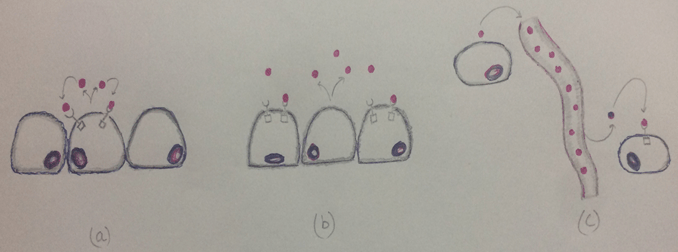This set of Cell Biology Multiple Choice Questions & Answers (MCQs) focuses on “Cell Signaling Systems”.
1. How many types of cell signaling are there?
a) 1
b) 2
c) 3
d) 4
View Answer
Explanation: There are three types of cell signaling pathways – autocrine, paracrine and endocrine. Cells communicate with each other through extracellular messenger molecules. Based on the distances these messenger molecules travel, the signaling pathways differ.
2. In which type of signaling, the cell that expresses messenger molecules also produces receptors?
a) autocrine
b) heterocrine
c) paracrine
d) endocrine
View Answer
Explanation: In autocrine signaling, the cells that express messenger molecules also synthesize surface receptors. Surface receptors can respond to the messengers synthesized by the cell itself.
3. Cell signaling is a process by which cells communicate.
a) True
b) False
View Answer
Explanation: Cell signaling is a process by which cells communicate and respond in a synergistic way to external stimuli. To carry out the activities in which an organism engages on a daily basis, it is essential that there be complex mechanisms and processes going on among the cells.
4. Paracrine messenger molecules are usually ________________
a) large
b) stable
c) unstable
d) amphoteric
View Answer
Explanation: Paracrine messenger molecules are unstable and cannot travel long distances in the body mostly because they are either degraded by the enzymes or they bind to the extracellular matrix.
5. Endocrine messengers are also called ___________________
a) hormones
b) receptors
c) antibody
d) antigen
View Answer
Explanation: Endocrine messengers are also called hormones and operate by the endocrine stimulation. In this pathway of cell signaling the messenger molecules travel through the bloodstream before reaching cell surface receptors that are distant.
6. The primary messenger molecules bind to the transmembrane receptors.
a) True
b) False
View Answer
Explanation: The primary messenger molecules bind to the transmembrane receptors to initiate intracellular responses such as transcription, translation, cell death (apoptosis). The second messenger molecules are then generated intracellularly to further the elicited response.
7. Protein kinases and phosphatases act by altering ______________ of the signaling proteins.
a) basicity
b) conformation
c) acidity
d) size
View Answer
Explanation: Protein kinases are enzymes that add phosphate groups while protein phosphatases remove phosphate groups. These enzymes alter the conformation of signaling proteins.
8. To which of the following residues of the protein, the protein kinases do not add phosphate groups?
a) serine
b) cytosine
c) threonine
d) tyrosine
View Answer
Explanation: The protein kinases usually add phosphate groups to serine and threonine residues of their target proteins. A very important class of kinases also adds phosphate groups to the tyrosine residues.
9. The process by which extracellular messages translate into intracellular changes is termed _________________
a) cell signaling
b) cell adhesion
c) signal transduction
d) cell transformation
View Answer
Explanation: The process by which extracellular messenger molecules transform into intracellular changes such as apoptosis, metabolism, transcription etc. is called signal transduction.
10. The a, b, and c respectively in the following image are _________________________

a) autocrine, paracrine, endocrine
b) autocrine, endocrine, paracrine
c) endocrine, paracrine, autocrine
d) endocrine, autocrine, paracrine
View Answer
Explanation: The signaling pathways in the figure shown are autocrine, paracrine and endocrine signaling pathways respectively. All the three are stimulation pathways in which messenger molecules reach cell surface receptors.
11. Steroids are derived from ________________
a) estrogen
b) cholesterol
c) proteins
d) carbohydrates
View Answer
Explanation: Steroids are hormones derived from cholesterol which carry messages by endocrine stimulation. Steroids regulate sexual differentiation, pregnancy, carbohydrate metabolism, and excretion of sodium and potassium ions.
12. Which messenger molecules are derived from arachidonic acid?
a) eicosanoids
b) terpenoids
c) corticoids
d) steroids
View Answer
Explanation: Eicosanoids are non-polar, 20-carbon containing molecules derived from the fatty acid, arachidonic acid. Eicosanoids regulate processes like blood pressure, inflammation, blood clotting. Several over-the-counter drugs used to treat headaches inhibit eicosanoid synthesis.
13. G-protein coupled receptors contain ________ transmembrane alpha helices.
a) 2
b) 5
c) 7
d) 9
View Answer
Explanation: The G-protein coupled receptors (GPCRs) are a family of cell surface receptors that consist of 7 transmembrane alpha helices. These receptors translate the binding of extracellular messengers to the activation of intracellular GTP-binding proteins.
Sanfoundry Global Education & Learning Series – Cell Biology.
To practice all areas of Cell Biology, here is complete set of 1000+ Multiple Choice Questions and Answers.
If you find a mistake in question / option / answer, kindly take a screenshot and email to [email protected]
- Check Biotechnology Books
- Practice Biotechnology MCQs
- Apply for Biotechnology Internship
- Check Cell Biology Books
